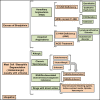Brazilian Guidelines for Hereditary Angioedema Management - 2017 Update Part 1: Definition, Classification and Diagnosis
- PMID: 29723342
- PMCID: PMC5910635
- DOI: 10.6061/clinics/2018/e310
Brazilian Guidelines for Hereditary Angioedema Management - 2017 Update Part 1: Definition, Classification and Diagnosis
Abstract
Hereditary angioedema is an autosomal dominant disease characterized by recurrent angioedema attacks with the involvement of multiple organs. The disease is unknown to many health professionals and is therefore underdiagnosed. Patients who are not adequately diagnosed and treated have an estimated mortality rate ranging from 25% to 40% due to asphyxiation by laryngeal angioedema. Intestinal angioedema is another important and incapacitating presentation that may be the main or only manifestation during an attack. In this article, a group of experts from the "Associação Brasileira de Alergia e Imunologia (ASBAI)" and the "Grupo de Estudos Brasileiro em Angioedema Hereditário (GEBRAEH)" has updated the Brazilian guidelines for the diagnosis and treatment of hereditary angioedema.
Figures




References
Publication types
MeSH terms
Substances
LinkOut - more resources
Full Text Sources
Other Literature Sources

